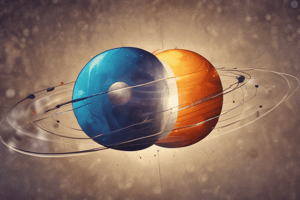Podcast
Questions and Answers
What does Newton's Second Law state about the relationship between force, mass, and acceleration?
What does Newton's Second Law state about the relationship between force, mass, and acceleration?
- Force is directly proportional to acceleration and inversely proportional to mass.
- Force is equal to mass multiplied by acceleration. (correct)
- Force is independent of both mass and acceleration.
- Force is the square of mass divided by acceleration.
Which statement accurately describes gravitational force according to the Universal Law of Gravitation?
Which statement accurately describes gravitational force according to the Universal Law of Gravitation?
- Gravitational force increases with increasing separation between two masses.
- Gravitational force is independent of the masses involved.
- Gravitational force is dependent on the distance squared between two masses. (correct)
- Gravitational force is equal to the product of their masses divided by the distance between them.
What effect does gravity have on tides?
What effect does gravity have on tides?
- Tides occur due to gravitational forces exerted by the moon and the sun. (correct)
- Tides are unaffected by the gravitational pull of celestial bodies.
- Tides are primarily caused by the rotation of the Earth.
- Tides only occur during full moons.
How does mass differ from weight?
How does mass differ from weight?
Which of the following is true about free fall?
Which of the following is true about free fall?
What does Newton's Second Law state about acceleration?
What does Newton's Second Law state about acceleration?
Which statement correctly describes the Universal Law of Gravitation?
Which statement correctly describes the Universal Law of Gravitation?
How is weight calculated?
How is weight calculated?
What effect does gravity have on celestial bodies?
What effect does gravity have on celestial bodies?
Which of the following is true about mass and weight?
Which of the following is true about mass and weight?
Flashcards are hidden until you start studying
Study Notes
Newton's Laws Of Gravitation
- First Law: An object remains at rest or in uniform motion unless acted on by an external force.
- Second Law: The force acting on an object is equal to the mass of the object multiplied by the acceleration (F = ma).
- Third Law: For every action, there is an equal and opposite reaction.
Universal Law Of Gravitation
- Definition: Every point mass attracts every other point mass with a force that is directly proportional to the product of their masses and inversely proportional to the square of the distance between them.
- Formula: F = G * (m1 * m2) / r²
- F: gravitational force
- G: gravitational constant (6.674 × 10⁻¹¹ N m²/kg²)
- m1, m2: masses of the objects
- r: distance between the centers of the two masses
Gravitational Force
- Nature: Acts at a distance, attractive force between two masses.
- Dependence on Mass: Gravitational force increases with the increase in either mass.
- Dependence on Distance: Gravitational force decreases as the distance between the objects increases.
Effects Of Gravity
- Weight: The force of gravity acting on an object. Weight varies with location due to varying gravitational pull.
- Orbit: The force of gravity keeps planets in orbit around the sun and moons around planets.
- Tides: Gravity plays a role in the ocean tides caused by the gravitational pull of the moon and the sun.
- Free Fall: Objects in free fall experience gravitational acceleration (approximately 9.8 m/s² on Earth).
Mass And Weight
-
Mass:
- Measure of the amount of matter in an object.
- Remains constant regardless of location.
- Measured in kilograms (kg).
-
Weight:
- The force exerted by gravity on an object (W = mg).
- Depends on the local gravitational field strength and varies with location.
- Measured in newtons (N).
Newton's Laws of Motion
- First Law (Inertia): An object at rest stays at rest, and an object in motion stays in motion at a constant speed and direction, unless acted upon by an unbalanced force. This means objects resist changes in their motion.
- Second Law (Acceleration): The acceleration of an object is directly proportional to the net force acting on it and inversely proportional to its mass. The equation F = ma relates force (F), mass (m), and acceleration (a).
- Third Law (Action-Reaction): For every action, there is an equal and opposite reaction. This means forces always come in pairs, acting on different objects.
Universal Law of Gravitation
- Definition: Every object in the universe attracts every other object with a force that is directly proportional to the product of their masses and inversely proportional to the square of the distance between their centers.
- Formula: F = G * (m₁ * m₂) / r²
- F: Gravitational force (measured in Newtons)
- G: Gravitational constant (6.674 × 10⁻¹¹ N m²/kg²)
- m₁ and m₂: Masses of the two objects (measured in kilograms)
- r: Distance between the centers of the two objects (measured in meters)
Characteristics of Gravitational Force
- Acts at a distance: Gravitational force doesn't require physical contact between objects; it acts over vast distances.
- Attractive: Gravitational force always pulls objects towards each other.
- Strength depends on mass: The greater the mass of the objects, the stronger the gravitational force between them.
- Strength depends on distance: The farther apart the objects are, the weaker the gravitational force between them.
Effects of Gravity
- Weight: The force of gravity exerted on an object by a planet or other celestial body.
- Orbital Motion: Gravity keeps planets orbiting the Sun and moons orbiting planets in elliptical paths.
- Tides: The gravitational pull of the Moon and Sun on Earth's oceans causes tides.
- Free Fall: Objects in free fall accelerate towards the Earth due to gravity, experiencing an acceleration of approximately 9.8 m/s².
Mass and Weight
- Mass: A fundamental property of matter, representing the amount of matter in an object. It's a scalar quantity (has magnitude only, not direction).
- Stays constant regardless of location.
- Measured in kilograms (kg).
- Weight: The force of gravity acting on an object's mass. It's a vector quantity (has both magnitude and direction).
- Depends on the local gravitational field strength.
- Therefore, weight can vary depending on location.
- Measured in Newtons (N).
Newton's Laws of Motion
- First Law: An object at rest will stay at rest, and an object in motion will continue moving at a constant speed in a straight line unless acted upon by a net external force.
- Second Law: The acceleration of an object is directly proportional to the net force acting upon it and inversely proportional to its mass. Simply put: Acceleration happens when a force acts upon a mass.
- Third Law: For every action, there is an equal and opposite reaction. Pushing off of the ground to jump creates a reaction force that pushes the earth away from you, though the earth's huge mass means this movement is imperceptible.
Universal Law of Gravitation
- Formulated by Isaac Newton, this law states that every particle in the universe attracts every other particle with a force that is:
- Directly proportional to the product of their masses: A larger object exerts a stronger gravitational force.
- Inversely proportional to the square of the distance between their centers: The farther away objects are, the weaker the gravitational attraction between them.
- Mathematically expressed as: F = G * (m1 * m2) / r²
- F = gravitational force
- G = universal gravitational constant (6.67 x 10^-11 N m²/kg²)
- m1, m2 = masses of the two objects
- r = distance between the centers of the two masses.
Gravitational Force
- The attractive force that acts between any two masses.
- Dependent upon:
- Mass of the objects involved (greater mass = greater force)
- Distance between the objects (greater distance = weaker force).
- Affects all objects with mass, leading to phenomena such as falling objects and orbital motions.
Mass and Weight
- Mass:
- Measure of the amount of matter in an object.
- Remains constant regardless of location.
- Measured in kilograms (kg).
- Weight:
- The gravitational force acting on an object.
- Depends on both mass and the acceleration due to gravity (g).
- Calculated as: Weight (W) = mass (m) * g
- g = 9.8 m/s² on Earth.
- Measured in newtons (N).
Effects of Gravity
- Causes objects to fall towards the Earth, providing a standard acceleration of 9.8 m/s².
- Holds planets, moons, and other celestial bodies in their orbits.
- Influences tides due to the gravitational pull of the moon and sun.
- Responsible for the formation of galaxies, stars, and planetary systems.
Studying That Suits You
Use AI to generate personalized quizzes and flashcards to suit your learning preferences.




